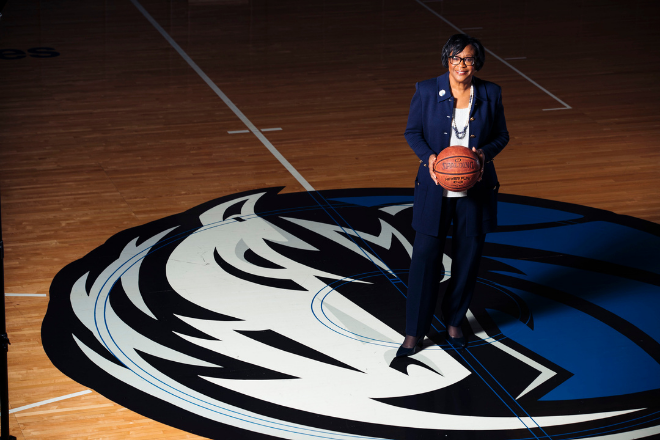Interview by Cecily Garber
Cynt Marshall is CEO of the Dallas Mavericks basketball team. When hired in this role in March 2018, she aimed for the organization to set the NBA standard for inclusion and diversity. Transparency, trust and a values-based leadership style evolved the company culture in her first 100 days.
Prior to the Mavs, Marshall founded Marshalling Resources, a consulting firm specializing in leadership, diversity and inclusion, culture transformation and overall optimization of people resources. Before that, she served as senior vice president – human resources and chief diversity officer at AT&T, where she spearheaded work that led to AT&T being named in the top three of DiversityInc’s 2017 Top 50 list of companies and that same year to Fortune’s 100 Best Companies To Work For list.
Net Assets: Independent school business office staff are tasked with an increasing array of responsibilities. You wrangled the suite of HR efforts at AT&T. With so many aspects of the field to consider, from day-to-day compliance to strategic issues, how did you prioritize your to-do list to make real change happen and create a high-performing and engaging work culture?
Cynt Marshall: I will say I prioritized it by number one, laying a foundation of trust. We had to define the culture. What truly makes a great place to work? What are the elements and how do you measure them? We conducted employee surveys to get a baseline for where we were.
Then I met with the leadership team. We conducted training and had conversations to really get their buy-in on kind of what kind of change needs to happen and their vision of a high performing team and an engaging work culture.
Finally, we considered the steps specific steps that we were going to take to achieve this great place to work. And we looked at the kind of things that are counter to that culture. It's one thing to lay out a plan that supports the kind of culture we want, but then we also needed to lay out an assessment of what was counter to the culture. For example, gender pay inequity may be one of those things. What are some of the policies, procedures and practices in place that go counter to a workplace where everybody's engaged, everybody can perform at a high level?
Then we made some leadership changes to reflect our commitment around diversity and inclusion. Increasing the number of women and people of color — for that matter, putting women and people of color — at the table sent some key messages
Net Assets: It’s been said that you transformed the culture of the Dallas Mavericks in 100 days, from one riddled by allegations of harassment and workplace misconduct to one that was high functioning. What steps made a difference, and how did you create trust and foster willingness to change?
Marshall: First of all, I would say that I did not transform the culture of the Dallas Mavericks alone. There are so many of us; the entire employee body rallied around a 100-day plan to really focus on making it a great place to work.
That plan included a few critical elements. The first was a vision statement. We had a goal to basically set the global standard for diversity and inclusion by 2019. So we were very deliberate about putting a stake in the ground. The second part was a set of values, which spell CRAFTS: character, respect, authenticity, fairness, teamwork and safety — both physical and emotional safety.
And then we made some leadership changes to reflect our commitment around diversity and inclusion. Increasing the number of women and people of color — for that matter, putting women and people of color — at the table sent some key messages. Then we conducted some training around inclusive behaviors, followed by a one-on-one with every single employee in the organization.
So, as for what steps make a difference in changing the culture, you have to have a clear vision and you have to have values-based employment, and you have to have buy-in from the leadership team. And you have to take steps so employees can see that you are serious from day one. I think spending time in all the one-on-ones getting to know people, getting to know their stories, getting to know the vision that they have for their career was very, very important.

Net Assets: In your experience, what are the most difficult aspects of creating a diverse, equitable and inclusive workplace culture?
Marshall: I would say it’s ensuring that everybody is on board, especially those in leadership positions and influential positions. It’s making sure that there's not somebody behind the scenes trying to do things counter to the culture that you're trying to establish. Those old cultures or subcultures tend to raise their head at the most inopportune times.
Then it’s understanding that it's about more than representation, that to really establish a high-performing team and an engaged culture is more than just diversity and the mix and the demographics, but it's truly about how people feel. Is there a sense of inclusion? How do people know they belong? You could do things like putting together employee resource groups, so people will have a safe place for belonging and allies and all that.
People are the heart — and I always say HeaRt with the H and the R in red capitalized — of any organization.
Net Assets: You’ve clearly made yourself an indispensable voice at the leadership table over the years. Can you offer advice on making the HR leader part of the senior leadership team?
Marshall: It sounds very simple, but just do it. People are the heart — and I always say HeaRt with the H and the R in red capitalized — of any organization. And to have an effective organization, you have to have an effective people strategy, and you have to execute almost flawlessly on that people's strategy. And there's no way do that without having the person who leads the people strategy at the table. You have to have a people strategy that goes along with the overall mission and vision of the organization. It is the most important strategy that you can have.
Net Assets: Switching gears, what factors helped you lead the Mavs through huge operational changes at the onset of the COVID-19 pandemic this spring? The NBA seems to have adapted well to changing circumstances, all things considered.
Marshall: I would point to one of our slogans in our business plan document that says, “Agility is the key to our success.” We have focused a lot on being agile. We already had a robust business continuity plan in place, which of course every business should have. Some call it an emergency preparedness plan. Whatever it is, you need that in place, and then you plug in the name of the crisis. In March, we executed our business continuity plan very quickly. Literally the night that the NBA shut down, we were the last game to be played.
First, we made sure that our people knew that they were going to get paid. We didn't want them to think they were going to have a financial crisis on top of a health crisis. We rallied the business office team together the very next morning, got them in a huddle and updated them on what was going on from an NBA league standpoint.
And then we sent everybody home in a manner where they were secure about their financial situation, with the tools they needed to do their job. We made sure that everybody had the technology they needed to work from home and understood the processes. We had counseling in place for those who needed it.
Then we shifted to consider the community. We said, we're not in the business of playing the game of basketball now, but we're playing the game of life with people. What are their needs? We developed a pretty intensive communication cadence since we were no longer in the office, and we still wanted to touch people, and we realized we needed to be in touch with them even more. We didn’t want people to feel isolated and wanted them to feel connected, and we still needed to figure out how we were going to deal with the business implications.
So we had a focus on physical, mental, emotional and spiritual health. And I think we've done a pretty good job at addressing those needs.
We developed a pretty intensive communication cadence since we were no longer in the office, and we still wanted to touch people, and we realized we needed to be in touch with them even more. We didn’t want people to feel isolated.
Net Assets: Another all-encompassing issue in U.S. is the heightened discourse around race relations. How has your work as a leader has adapted to this national discourse? What has been effective?
Marshall: A few things. We went from pivoting with the COVID-19 situation, where we had to change our business model — and ended up in the PPE business — and ended up being a leader in unifying people and hosting conversations around race relations.
I would highlight our Courageous Conversation held on June 9, with the theme, “Listen, Learn, Unite.” We took our natural role as conveners and as unifiers and brought people together to discuss the killing of George Floyd and the difficult aftermath. We had about a dozen speakers, including Dallas Police Chief Reneé Hall, Mavs assistant coaches Stephen Silas and Jamahl Mosley, and former Mavs players Sam Perkins and Cedric Ceballos.
I think it has been very effective. We have developed ourselves as leaders in the diversity and inclusion space and been very visible about that, with the Dallas Regional Chamber of Commerce and other organizations that we’re helping.
We had credibility as we started to talk about the race relations issues, which has helped. We have a diverse leadership team and a diverse employee body. And we were involved already in the community. We have employee resource groups that are involved and a workforce that's very involved in these issues. They have a lot of passion for it, and they are stepping up.



